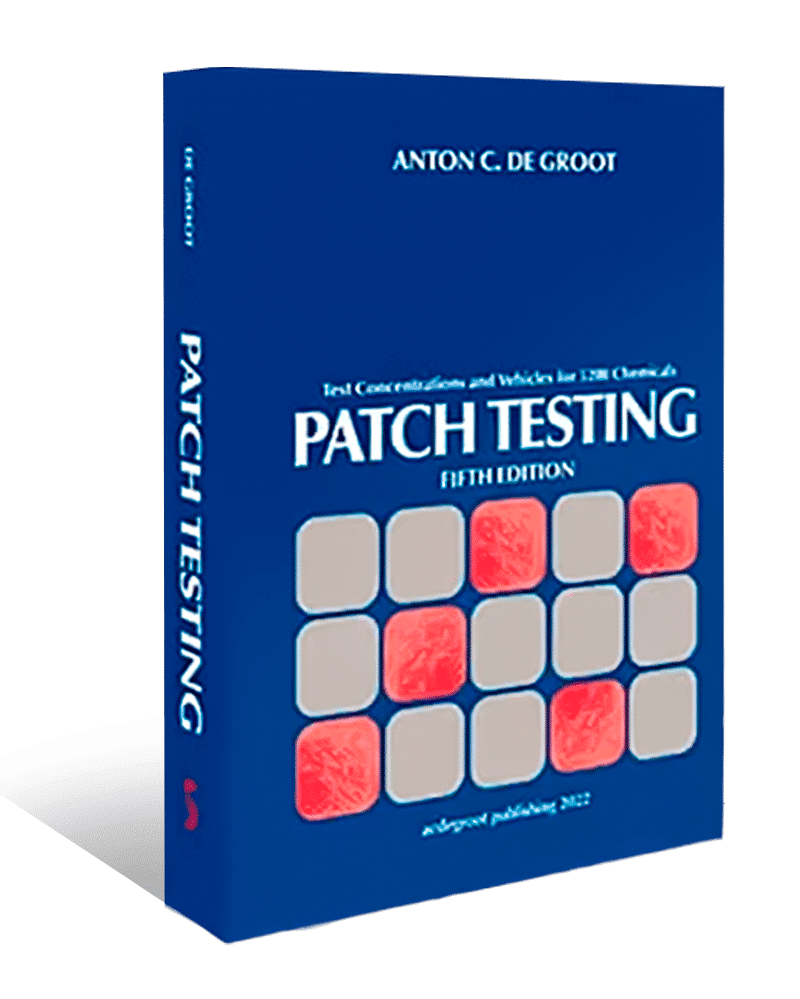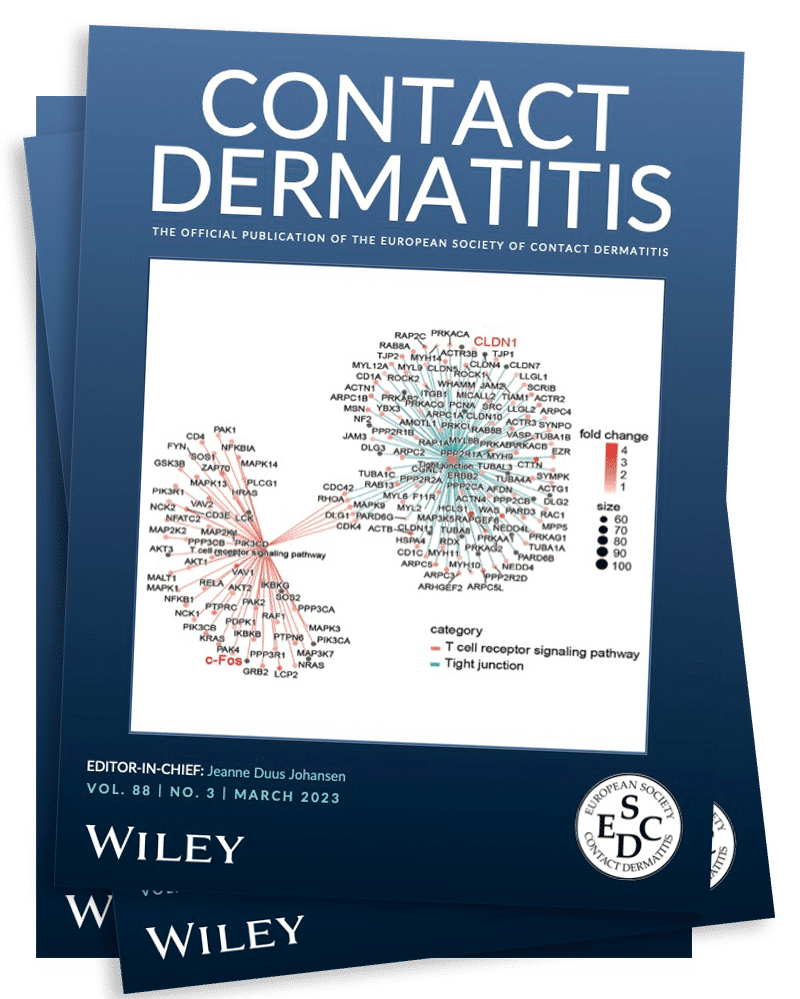Welcome to our website
Are you in doubt about a diagnosis, the choice of an allergen or just curious?
Then ask your colleagues
…to guidelines, master classes, reference books, the journal Contact Dermatitis and participate in task forces influencing policies in Europe.
The European Society of Contact Dermatitis (ESCD) is the leading source of expertise, in the field of cutaneous allergy, environmental and occupational dermatitis.
Recommendations of the European
Society of Contact Dermatitis
many open access in:
Contact Dermatitis
Patch Testing 5th Edition
The full text of Anton de Groot’s well-known book Patch Testing (5th edition, 2022) is available to all members of the Society. A big thank you from The Executive Committee goes out to Dr de Groot for his generous donation of the book.

The Journal Contact Dermatitis is the official journal of the ESCD. It publishes scientific discoveries in the field of cutaneous allergy, environmental and occupational dermatitis, including chemical aspects, immunology, and drug reactions. Its impact factor is (2021):6.4
(free for members)


The ESCD promotes interest in contact dermatitis and environmental & occupational skin diseases
Dr Mihály (“Misi”) Matura
secretary@escd.org
🤓Want to hear more about contact allergy?
😎Join us at the ESCD Congress in beautiful Dresden!
escd2024.com ... See MoreSee Less
💡New publication alert: High content of hexavalent chromium in cement samples from three African countries (doi.org/10.1111/cod.14638)
☝️Hexavalent chromium is an important contact allergen traditionally found in cement
This study showed that in six of eight cement samples from three African countries, the Cr(VI) content was ≥16 mg/kg, more than eight times the maximal allowed concentration in the EU.
This finding suggests that high hexavalent chromium concentrations in cement in three African countries may contribute to the high prevalence of chromium contact allergy seen in these regions.
Regulating the allowed levels of contact allergens in commonly used substances is key to preventing contact allergy across the world! ... See MoreSee Less
Hope to see many of you at the Congress of the European Society of Contact Dermatitis in Dresden, Germany from 4th to 7th September 2024 🤞
Congress Highlights:
· Updates on hand eczema including occupational aspects, molecular patterns, prevention and new treatment options.
· Dedicated sessions on contact allergies to cosmetics, implants and footwear, urticaria, angioedema, drug reactions and atopic dermatitis.
· Learn about tips and tricks in patch testing, including children.
You can see the full program here: escd2024.com/
Have a great summer – see you in Dresden 🌻 🌼 ... See MoreSee Less
🖐 At ESCD 2024, you will learn much more about contact allergy and the mystery of Antabuse and rubber gloves when Dr. Christoffer Kursawe Larsen presents cutting-edge research on the cross-reactivity between Antabuse and dithiocarbamates using mouse models.
💡 See you in Dresden, September 4-7, 2024: escd2024.com
#science #research #dermatitis ... See MoreSee Less
😎 The ESCD 2024 congress is coming closer and closer - so please do not forget to register (escd2024.com/).
🔬 The scientific program covers a broad range of topics in the field, including the latest advances in basic and translational research, updates on the diagnosis and prevention of contact dermatitis, allergic and inflammatory skin diseases, current and emerging therapies, and presentations on the latest clinical studies and their implications for patient care.
👩🔬 The ESCD congress will provide a platform for delegates and industry to network with leading experts in the field, to participate in different session formats, such as plenaries, focus sessions, educational sessions and poster presentations, deepening their understanding of the latest research and practices in the field.
💛 We look forward to welcoming you to Dresden 2024.
#science #Congress #dermatitis ... See MoreSee Less
💡 Publication alert: ESCD position paper on patch testing
🔬 Patch testing is the only clinically applicable diagnostic method for Type IV allergy. The availability of Type IV patch test (PT) allergens in Europe, however, is currently scarce. This severely compromises adequate diagnostics of contact allergy, leading to serious consequences for the affected patients.
⚗ Against this background, the European Society of Contact Dermatitis (ESCD) has created a task force (TF) (i) to explore the current availability of PT substances in different member states, (ii) to highlight some of the unique characteristics of Type IV vs. other allergens and (iii) to suggest ways forward to promote and ensure availability of high-quality patch testing substances for the diagnosis of Type IV allergies throughout Europe.
⚖ The suggestions of the TF on how to improve the availability of PT allergens are supported by the ESCD, the European Academy of Allergy and Clinical Immunology, and the European Academy of Dermatology and Venereology and intend to provide potential means to resolve the present medical crisis.
Full text available at (open access): doi.org/10.1111/cod.14580
#science #allergy #dermatitis #dermatology ... See MoreSee Less
Severely compromised supply of patch test allergens in Europe hampers adequate diagnosis of occupational and non‐occupational contact allergy. A European Society of Contact Dermatitis (ESCD), European Academy of Allergy and Clinical Immunology...
doi.org
Contact Dermatitis is a dermatology journal focusing on allergic and irritant (toxic) types of contact dermatitis, and occupational and consumers’ dermatitis.💡 Research alert: Intensive care unit nurses are at high risk for developing hand dermatitis due to their frequent exposure to wet-work.
🔬 A symptom-based questionnaire concerning hand dermatitis was distributed.
🎯 The point-prevalence was 9.8%, the 1-year prevalence was 26.6%, and 60.9% reported at least one symptom of hand dermatitis.
🌟 These figures highlight the need for a prevention program.
Find the full text (open access) under: doi.org/10.1111/cod.14568
#science #dermatitis #allergy #healthcare #nurse ... See MoreSee Less
💡 Research alert: Gender differences in allergic contact dermatitis to common allergens
🔬 Boonchai et al. investigated the differences and trends in contact allergy from a sex perspective and found that:
i) females are more prone to developing reactions related to metals found in costume jewellery and allergens present in personal care products
ii) males are more likely to experience occupationally induced contact allergies.
Find the full text (open access) on: doi.org/10.1111/cod.14479
#science #dermatitis #allergy ... See MoreSee Less
We're looking very much forward to meeting you all at the ESCD Congress in September! Please note that the deadline for submitting your abstract has been extended to Monday 15th April 2024. Feel free to take this chance and share your valuable research with us: escd2024.com/upload/
#science #dermatitis #congress #research ... See MoreSee Less